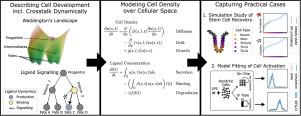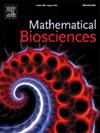A dynamic model for Waddington’s landscape accounting for cell-to-cell communication
IF 1.8
4区 数学
Q2 BIOLOGY
引用次数: 0
Abstract
Waddington’s landscape provides a conceptual model for developmental processes. It is the basis of various mathematical models describing cell maturation and development at cell and population levels. Yet, these mathematical models mostly disregard cell-to-cell communication, an essential process that modulates cellular decision-making and population dynamics.
In this study, we provide a dynamical model for cell maturation and development which can be seen as an extension of Waddington’s landscape. The coupled system of partial and ordinary differential equations describes cell density along the cell state together with ligand concentrations. Cell-state-dependent ligand production determines ligand availability, which controls population-level processes. We provide proof of the existence and uniqueness of solutions for our coupled differential equation system and demonstrate the model’s validity by analyzing single-cell transcriptomics data. Our results show that cell-to-cell communication is essential for accurately depicting biological recovery processes, such as the regeneration of stem cells in the intestine’s crypt and the response of immune cells upon LSP stimulation.
Our findings underscore the importance of incorporating cell-to-cell communication into mathematical models of biological development. By doing so, we unlock the potential for deeper insights into complex processes such as tissue regeneration and immune responses, offering new avenues for understanding and predicting the dynamics of biological recovery and cell activation.

沃丁顿景观的动态模型,用于解释细胞间的通信。
沃丁顿的景观为发展过程提供了一个概念模型。它是在细胞和群体水平上描述细胞成熟和发育的各种数学模型的基础。然而,这些数学模型大多忽略了细胞间的通信,这是调节细胞决策和种群动态的基本过程。在这项研究中,我们提供了一个细胞成熟和发育的动态模型,可以看作是沃丁顿景观的延伸。偏微分方程和常微分方程的耦合系统描述了沿着细胞状态的细胞密度和配体浓度。细胞状态依赖性配体的产生决定了配体的可用性,从而控制了种群水平的过程。通过对单细胞转录组学数据的分析,证明了该耦合微分方程组解的存在性和唯一性,并证明了该模型的有效性。我们的研究结果表明,细胞间通信对于准确描述生物恢复过程至关重要,例如肠隐窝中干细胞的再生和免疫细胞对LSP刺激的反应。我们的发现强调了将细胞间通讯纳入生物发育数学模型的重要性。通过这样做,我们解锁了深入了解组织再生和免疫反应等复杂过程的潜力,为理解和预测生物恢复和细胞激活的动力学提供了新的途径。
本文章由计算机程序翻译,如有差异,请以英文原文为准。
求助全文
约1分钟内获得全文
求助全文
来源期刊

Mathematical Biosciences
生物-生物学
CiteScore
7.50
自引率
2.30%
发文量
67
审稿时长
18 days
期刊介绍:
Mathematical Biosciences publishes work providing new concepts or new understanding of biological systems using mathematical models, or methodological articles likely to find application to multiple biological systems. Papers are expected to present a major research finding of broad significance for the biological sciences, or mathematical biology. Mathematical Biosciences welcomes original research articles, letters, reviews and perspectives.
 求助内容:
求助内容: 应助结果提醒方式:
应助结果提醒方式:


